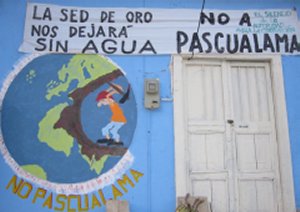09 de Marzo de 2016
 Mural at the Church in Alto del Carmen (Photoby Fabiana Li) |



Minería a gran escala / Glaciares / Contaminación del agua / Minería transfronteriza / Pascua-Lama /
Proyecto Pascua-Lama:
SEA Atacama realiza visita técnica por EIA “Modificación Fase de Cierre Pascua Lama” (23/02/2024)
Dirección General de Aguas investiga denuncia sobre contaminación de ríos por proyecto minero Pascua Lama (17/02/2023)
Demanda colectiva contra Barrick Gold por dar falsas declaraciones medioambientales (14/01/2023)
Pascua Lama: Corte Suprema rechaza recurso de casación y confirma fallo de Tribunal Ambiental que sancionó a proyecto minero en proceso de cierre (14/07/2022)
Maricunga, Pascua Lama y Vizcachitas: Los cuestionados proyectos que Boric omitió en su visita a Canadá (13/06/2022)
Evalúan avances en actividades de cierre de Pascua Lama (25/03/2022)
Comunidad logra fallo histórico de la Corte Suprema: Demuestran que Barrick Gold desobedece cierre de Pascua Lama y se ordena a las autoridades supervisarla de manera efectiva (08/02/2022)
Corte Suprema acusa a Pascua Lama de incumplir el plan de cierre y ordena fiscalización de autoridades (05/02/2022)
Denuncian a minera Barrick Gold por río que sigue contaminado al no cerrar su proyecto Pascua Lama (12/11/2021)
Acusan a Minera Barrick Gold de contaminar río en el cierre de Pascua Lama (02/11/2021)
Chile - Minería a gran escala
“Respaldamos la voluntad popular”: Cores del Biobío rechazan proyecto minero de tierras raras en Penco (26/07/2024)
La abandonada planta piloto que impulsó el negocio minero de tierras raras en los cerros de Penco (21/07/2024)
Litio: la locura blanca (18/07/2024)
Conversatorio “Voces del Salar: Explorando los impactos de la Estrategia Nacional del Litio” (12/07/2024)
Una dignidad que no cabe en el bolsillo empresarial (11/07/2024)
Codelco, Enami y Quiborax: Las empresas que están a la vuelta de la esquina para explotar salares (05/07/2024)
Consejo de Defensa del Estado presenta demanda contra minera Quiborax por daño ambiental al Salar de Surire (03/07/2024)
Momento crucial para comunidades del Norte Grande: Después de 30 años BHP Billiton implementa plan de cierre de Cerro Colorado (03/07/2024)
Localidad “El Sobrante” y cuenca del río Petorca amenazada por proyecto de exploración minera de la empresa Newmont (23/06/2024)
Invitan a Trawün-conversatorio sobre Resistencias frente a la amenaza minera en la Fütawillimapu (19/06/2024)
Glaciares
Saúl Luciano Lliuya contra RWE: se espera un dictamen pericial en verano. Perú (24/05/2023)
Contaminación del agua
La científica que detectó los ‘químicos eternos’ en la sangre y fue silenciada por la industria: “Se podría haber evitado”. Estados Unidos (13/07/2024)
Firmas y sellos falsos figuran en la aprobación de licencia ambiental de mina Cerro Blanco, señala ministra. Guatemala (24/04/2024)
Ver más:
Minería a gran escala / Glaciares / Contaminación del agua / Minería transfronteriza / Pascua-Lama /